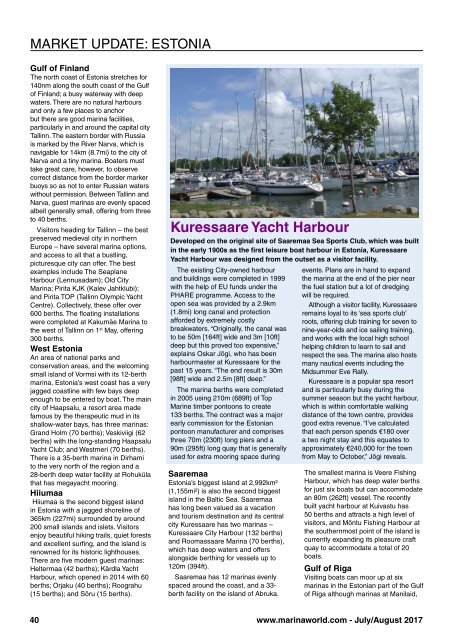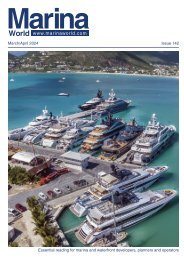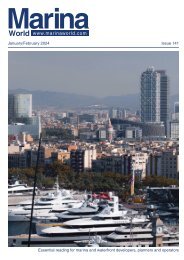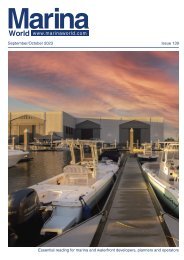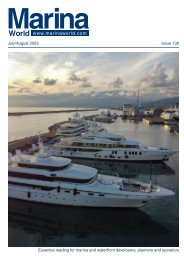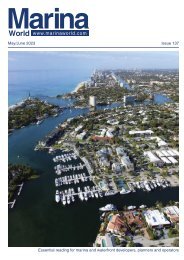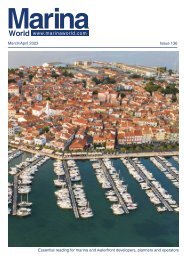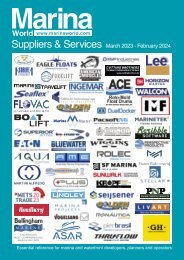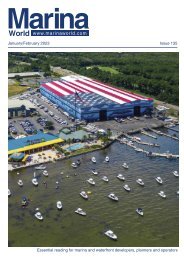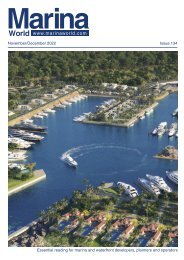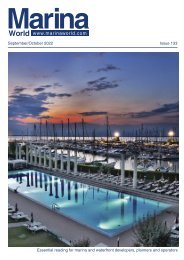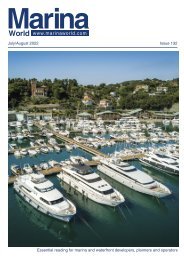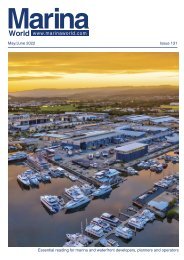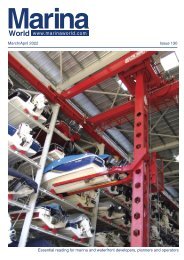2017 July August Marina World
The magazine for the marina industry
The magazine for the marina industry
You also want an ePaper? Increase the reach of your titles
YUMPU automatically turns print PDFs into web optimized ePapers that Google loves.
MARKET UPDATE: ESTONIA<br />
Gulf of Finland<br />
The north coast of Estonia stretches for<br />
140nm along the south coast of the Gulf<br />
of Finland; a busy waterway with deep<br />
waters. There are no natural harbours<br />
and only a few places to anchor<br />
but there are good marina facilities,<br />
particularly in and around the capital city<br />
Tallinn. The eastern border with Russia<br />
is marked by the River Narva, which is<br />
navigable for 14km (8.7mi) to the city of<br />
Narva and a tiny marina. Boaters must<br />
take great care, however, to observe<br />
correct distance from the border marker<br />
buoys so as not to enter Russian waters<br />
without permission. Between Tallinn and<br />
Narva, guest marinas are evenly spaced<br />
albeit generally small, offering from three<br />
to 40 berths.<br />
Visitors heading for Tallinn – the best<br />
preserved medieval city in northern<br />
Europe – have several marina options,<br />
and access to all that a bustling,<br />
picturesque city can offer. The best<br />
examples include The Seaplane<br />
Harbour (Lennusadam); Old City<br />
<strong>Marina</strong>; Pirita KJK (Kalev Jahtklubi);<br />
and Pirita TOP (Tallinn Olympic Yacht<br />
Centre). Collectively, these offer over<br />
600 berths. The floating installations<br />
were completed at Kakumäe <strong>Marina</strong> to<br />
the west of Tallinn on 1 st May, offering<br />
300 berths.<br />
West Estonia<br />
An area of national parks and<br />
conservation areas, and the welcoming<br />
small island of Vormsi with its 12-berth<br />
marina, Estonia’s west coast has a very<br />
jagged coastline with few bays deep<br />
enough to be entered by boat. The main<br />
city of Haapsalu, a resort area made<br />
famous by the therapeutic mud in its<br />
shallow-water bays, has three marinas:<br />
Grand Holm (70 berths); Veskiviigi (62<br />
berths) with the long-standing Haapsalu<br />
Yacht Club; and Westmeri (70 berths).<br />
There is a 35-berth marina in Dirhami<br />
to the very north of the region and a<br />
28-berth deep water facility at Rohuküla<br />
that has megayacht mooring.<br />
Hiiumaa<br />
Hiiumaa is the second biggest island<br />
in Estonia with a jagged shoreline of<br />
365km (227mi) surrounded by around<br />
200 small islands and islets. Visitors<br />
enjoy beautiful hiking trails, quiet forests<br />
and excellent surfing, and the island is<br />
renowned for its historic lighthouses.<br />
There are five modern guest marinas:<br />
Heltermaa (42 berths); Kärdla Yacht<br />
Harbour, which opened in 2014 with 60<br />
berths; Orjaku (40 berths); Roograhu<br />
(15 berths); and Sõru (15 berths).<br />
Kuressaare Yacht Harbour<br />
Developed on the original site of Saaremaa Sea Sports Club, which was built<br />
in the early 1900s as the first leisure boat harbour in Estonia, Kuressaare<br />
Yacht Harbour was designed from the outset as a visitor facility.<br />
The existing City-owned harbour<br />
and buildings were completed in 1999<br />
with the help of EU funds under the<br />
PHARE programme. Access to the<br />
open sea was provided by a 2.9km<br />
(1.8mi) long canal and protection<br />
afforded by extremely costly<br />
breakwaters. “Originally, the canal was<br />
to be 50m [164ft] wide and 3m [10ft]<br />
deep but this proved too expensive,”<br />
explains Oskar Jõgi, who has been<br />
harbourmaster at Kuressaare for the<br />
past 15 years. “The end result is 30m<br />
[98ft] wide and 2.5m [8ft] deep.”<br />
The marina berths were completed<br />
in 2005 using 210m (689ft) of Top<br />
Marine timber pontoons to create<br />
133 berths. The contract was a major<br />
early commission for the Estonian<br />
pontoon manufacturer and comprises<br />
three 70m (230ft) long piers and a<br />
90m (295ft) long quay that is generally<br />
used for extra mooring space during<br />
Saaremaa<br />
Estonia’s biggest island at 2,992km²<br />
(1,155mi²) is also the second biggest<br />
island in the Baltic Sea. Saaremaa<br />
has long been valued as a vacation<br />
and tourism destination and its central<br />
city Kuressaare has two marinas –<br />
Kuressaare City Harbour (132 berths)<br />
and Roomassaare <strong>Marina</strong> (70 berths),<br />
which has deep waters and offers<br />
alongside berthing for vessels up to<br />
120m (394ft).<br />
Saaremaa has 12 marinas evenly<br />
spaced around the coast, and a 33-<br />
berth facility on the island of Abruka.<br />
events. Plans are in hand to expand<br />
the marina at the end of the pier near<br />
the fuel station but a lot of dredging<br />
will be required.<br />
Although a visitor facility, Kuressaare<br />
remains loyal to its ‘sea sports club’<br />
roots, offering club training for seven to<br />
nine-year-olds and ice sailing training,<br />
and works with the local high school<br />
helping children to learn to sail and<br />
respect the sea. The marina also hosts<br />
many nautical events including the<br />
Midsummer Eve Rally.<br />
Kuressaare is a popular spa resort<br />
and is particularly busy during the<br />
summer season but the yacht harbour,<br />
which is within comfortable walking<br />
distance of the town centre, provides<br />
good extra revenue. “I’ve calculated<br />
that each person spends €180 over<br />
a two night stay and this equates to<br />
approximately €240,000 for the town<br />
from May to October,” Jõgi reveals.<br />
The smallest marina is Veere Fishing<br />
Harbour, which has deep water berths<br />
for just six boats but can accommodate<br />
an 80m (262ft) vessel. The recently<br />
built yacht harbour at Kuivastu has<br />
50 berths and attracts a high level of<br />
visitors, and Mõntu Fishing Harbour at<br />
the southernmost point of the island is<br />
currently expanding its pleasure craft<br />
quay to accommodate a total of 20<br />
boats.<br />
Gulf of Riga<br />
Visiting boats can moor up at six<br />
marinas in the Estonian part of the Gulf<br />
of Riga although marinas at Manilaid,<br />
40<br />
www.marinaworld.com - <strong>July</strong>/<strong>August</strong> <strong>2017</strong>


